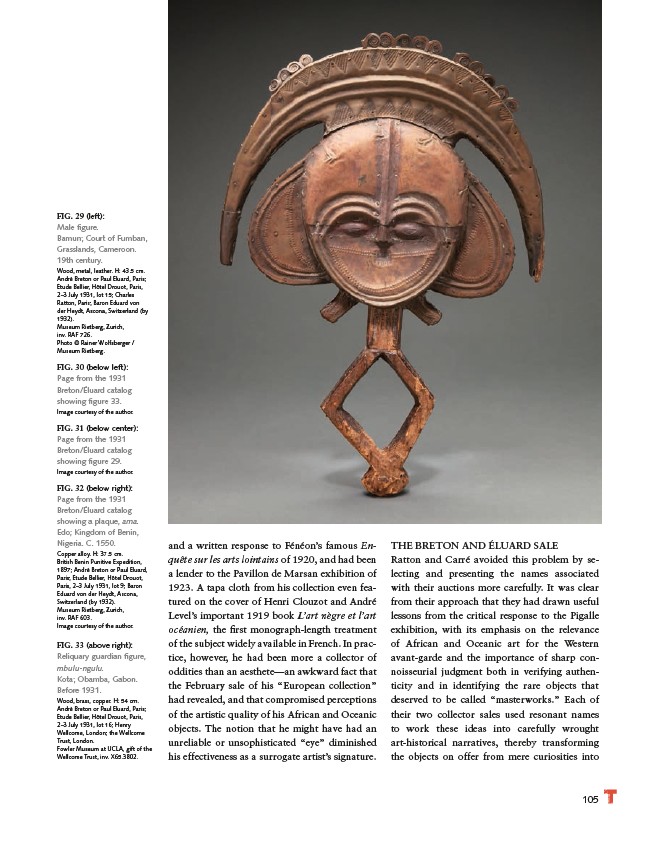
PARIS 1931
105
FIG. 29 (left):
Male figure.
Bamun; Court of Fumban,
Grasslands, Cameroon.
19th century.
Wood, metal, leather. H: 43.5 cm.
André Breton or Paul Éluard, Paris;
Étude Bellier, Hôtel Drouot, Paris,
2–3 July 1931, lot 15; Charles
Ratton, Paris; Baron Eduard von
der Heydt, Ascona, Switzerland (by
1932).
Museum Rietberg, Zurich,
inv. RAF 726.
Photo © Rainer Wolfsberger /
Museum Rietberg.
FIG. 30 (below left):
Page from the 1931
Breton/Éluard catalog
showing figure 33.
Image courtesy of the author.
FIG. 31 (below center):
Page from the 1931
Breton/Éluard catalog
showing figure 29.
Image courtesy of the author.
FIG. 32 (below right):
Page from the 1931
Breton/Éluard catalog
showing a plaque, ama.
Edo; Kingdom of Benin,
Nigeria. C. 1550.
Copper alloy. H: 37.5 cm.
British Benin Punitive Expedition,
1897; André Breton or Paul Eluard,
Paris; Étude Bellier, Hôtel Drouot,
Paris, 2–3 July 1931, lot 9; Baron
Eduard von der Heydt, Ascona,
Switzerland (by 1932).
Museum Rietberg, Zurich,
inv. RAF 603.
Image courtesy of the author.
FIG. 33 (above right):
Reliquary guardian figure,
mbulu-ngulu.
Kota; Obamba, Gabon.
Before 1931.
Wood, brass, copper. H: 54 cm.
André Breton or Paul Eluard, Paris;
Étude Bellier, Hôtel Drouot, Paris,
2–3 July 1931, lot 16; Henry
Wellcome, London; the Wellcome
Trust, London.
Fowler Museum at UCLA, gift of the
Wellcome Trust, inv. X65.3802.
and a written response to Fénéon’s famous Enquête
sur les arts lointains of 1920, and had been
a lender to the Pavillon de Marsan exhibition of
1923. A tapa cloth from his collection even featured
on the cover of Henri Clouzot and André
Level’s important 1919 book L’art nègre et l’art
océanien, the first monograph-length treatment
of the subject widely available in French. In practice,
however, he had been more a collector of
oddities than an aesthete—an awkward fact that
the February sale of his “European collection”
had revealed, and that compromised perceptions
of the artistic quality of his African and Oceanic
objects. The notion that he might have had an
unreliable or unsophisticated “eye” diminished
his effectiveness as a surrogate artist’s signature.
THE BRETON AND ÉLUARD SALE
Ratton and Carré avoided this problem by selecting
and presenting the names associated
with their auctions more carefully. It was clear
from their approach that they had drawn useful
lessons from the critical response to the Pigalle
exhibition, with its emphasis on the relevance
of African and Oceanic art for the Western
avant-garde and the importance of sharp connoisseurial
judgment both in verifying authenticity
and in identifying the rare objects that
deserved to be called “masterworks.” Each of
their two collector sales used resonant names
to work these ideas into carefully wrought
art-historical narratives, thereby transforming
the objects on offer from mere curiosities into